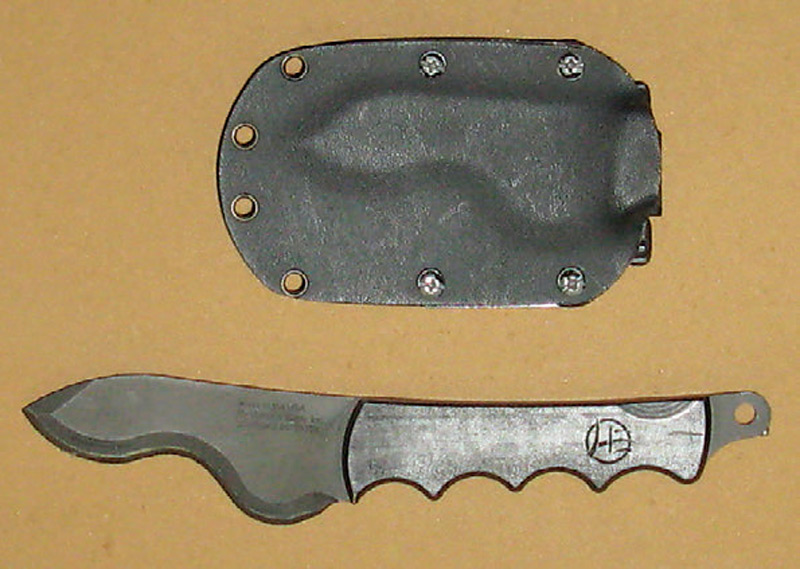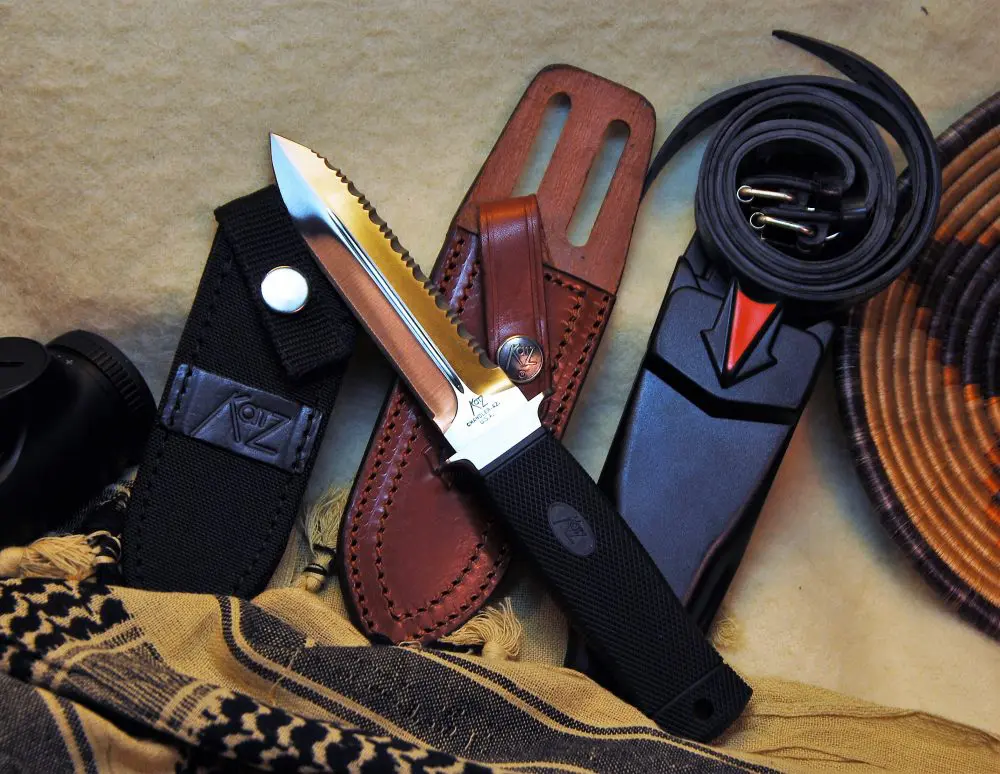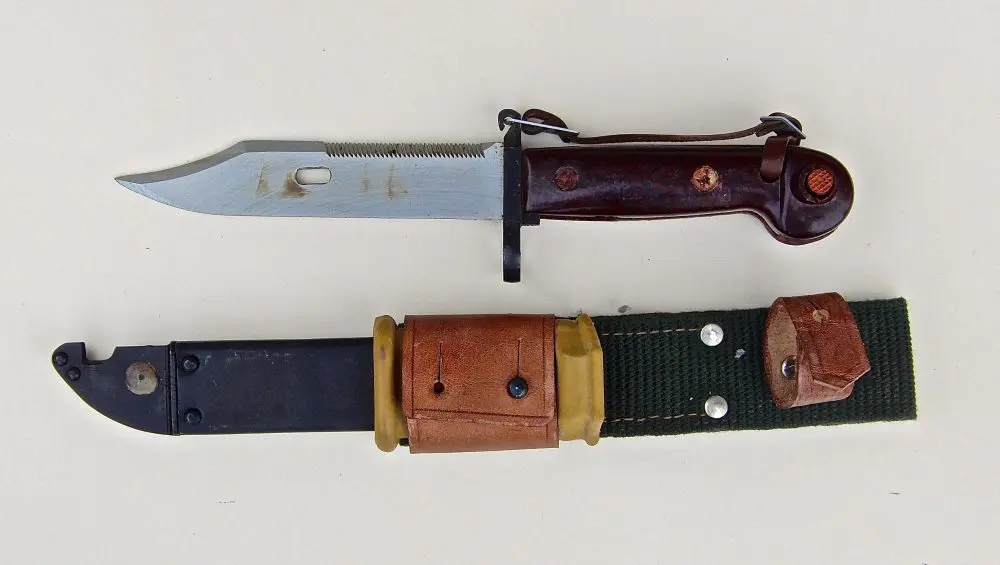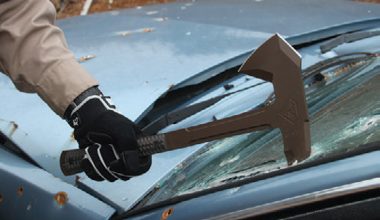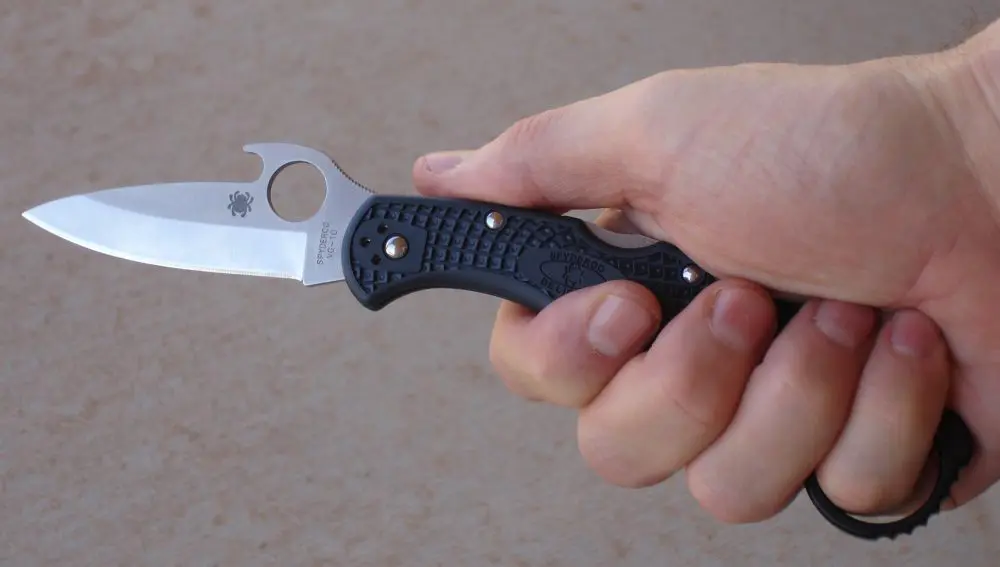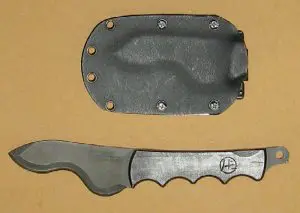
There is no denying that blades in capable and determined hands can be devastating and turn a larger and more belligerent opponent into hamburger.
Knife fighting is not for the squeamish, and most Westerners would prefer to shoot someone rather than stick them, or be shot rather than sliced and diced while watching it as it’s happening. I believe that knives, the “weapons of passion,” can be more intimidating than a gun.
Table of Contents
HUTTON’S EDGE TACTICAL KNIFE
This is no ordinary 8.1-ounce fighting knife. Although 30 years in development, its blade shape reminds me of the Filipino Kris’ wavy, snake-like doubleedged blade.
The HETK’s combined weight with custom Kydex sheath is 12.9 ounces of fist fury. Its four-inch wave-like blade is 0.194 inch thick and made of newly patented S30-V Crucible steel with Black-T coating. Its Linen Micarta finger-grooved grip is 0.721 inch thick. Overall length reaches 9 1/8 inches, and its shank is completed with a rounded butt that’s holed for a lanyard and tipped with “The Thumper,” a variable-diameter window-shattering emergency extraction stud.
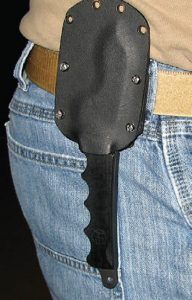
But its primary purpose is personal protection, with an emphasis on defense that can quickly transition to offense via Hutton’s system. The Commercial Police HETK is carried inverted on the belt encased in a custom Kydex molded sheath. Each knife is slightly different, hence each one gets a custom sheath. The Tek-Lok retainer snaps on and off the belt. Retention is quite good, yet the knife deploys quickly.
There are four versions of the fixed blade, including a handmade Damascus Steel Limited Edition for $1,200 to $1,700, and four folding-knife variations. Suggested retail for the HETK varies from $575 to $650, depending on the model. Prices include the Tek-Lok Kydex sheath.
Training and certification for the fixed blade are mandatory for military members and law enforcement professionals. Civilians are strongly encouraged to take advantage of the training, because as D.P. Hutton, inventor of the HETK, advises, “The knife is no good without the instruction.”
Training is not mandatory for the folder, but recommended because of the extra steps involved in deployment. All these knives are “warranted for life and guaranteed forever.”
Hutton confided that he has been thinking of designing a more effective knife since age 16. He began training at age 13 and has matured into a hard-core martial artist. He defeated an ROK Marine in an exhibition match on Okinawa while in the Corps. Hutton is a former Marine, veteran police officer, criminologist, and security advisor who holds several U.S. patents.
He stated that the HETK is a defensive instrument because it and his technique target the opponent’s appendages to render them inoperable. With appropriate force generated by a two-handed grip, the knife can slice “straight through bone.”
In addition to police acquisition, DEA agents in one Western field office use them for backup weapons but also consider the HETK a close quarters option in crowded venues where gunfire is likely to cause collateral casualties.
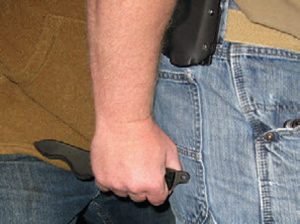
KISS SYSTEM
Most martial artists spend decades— even lifetimes—engaged in complicated disciplines involving weaponless and weapons defense, but Hutton wisely adopted KISS, the most reliable standard for training and operational success.
Trainers usually opt for simple but effective techniques that will remain with the officer and do not require frequent training to retain. Hutton’s are so simple it took me 20 minutes to acquire the basic concepts.
Hutton’s police version is usually worn on the same side that the officer carries his pistol, and placed immediately behind it. It is designed for onehanded pull-down extraction because the officer’s belt order is crowded with myriad weapons and gizmos that are designed to be lifted up to deploy. But if the officer is bear hugged by a strong perpetrator, his arms are pinned to his sides and he cannot break contact, he will not be able to draw his sidearm or pocket folder. If armed with an HETK, he could extract it and stab rearward, puncturing the leg and groin of his assailant to force his release.
SLASH OVER THRUST
The HETK is more of a slashing tool, and the first purpose of the system is to stop the fight rather than attempt to kill the opponent.
Multiple slashes produce more tissue damage and precipitate grave psychological trauma, because they can be seen and felt by the threat while they are occurring. Tremendous amounts of blood are evident, and the recipient has no idea how badly he is hurt. In one practitioner’s opinion, the stab is the “least effective way to disable.”
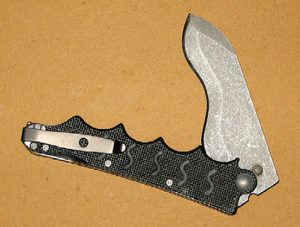
With the knife, you block impact weapon or knife attacks, followed by tendon-disabling slashes to the inside wrists and forearms. If the attacker needs to be further disabled, a “push grip” is assumed. The support hand is brought over the top of the dominant hand and slid behind it to brace it for a two-handed forward punch to his throat or neck.
Once the hands of the attacker are disabled, his center mass is the next target, should it be necessary. The waveshaped blade with its thickness cleaves more tissue than a straight blade and inflicts a wider wound incision.
Defensively, the knife, in a reversedominant handgrip, is brought up in a two-handed grip that is identical to your two-handed thumbs-forward handgun grip. The blade is forward to the opponent and braced against the side of the wrist and forearm. It is held at throat level just under the chin and, in your fighting stance, you wait for the assailant to come to you.
The reverse grip is anathema to many martial artists because it gives up reach. This is true and, if the attacker deploys a gun and escape is impossible, HETK wielders are taught to rush the gunman with a push grip, get inside and attack. The HETK is by no means limited to slashing and can be used conventionally, point forward. The reverse grip has proven better for retention.
One other advantage of the system is you don’t have to be physically fit to employ it. Training blades are available, and Hutton is working on concealedcarry versions.
CONCLUSIONS
Many American males carry a clipmounted folding knife but possess only intuitive skills on how to employ it for self-defense. The HETK is no ordinary knife, and when legitimately introduced into a self-defense event, its lethal profile may stop fights before they progress very far. The blade, defensive stance and grip also project skill and confidence that will give pause to aggressors who still have their wits about them.
Professionals and serious self– defense oriented citizens will be well armed with the HETK.
